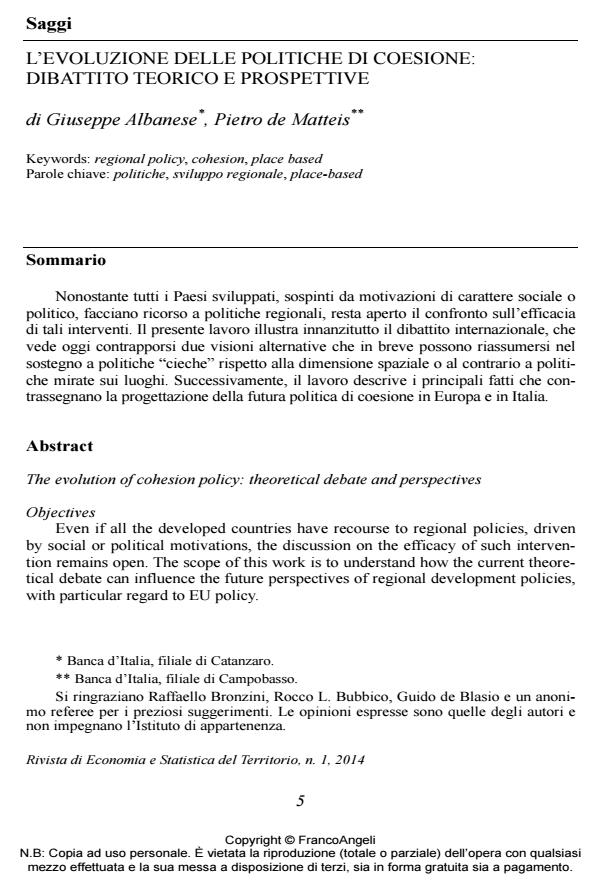The evolution of cohesion policy: theoretical debate and perspectives
Journal title RIVISTA DI ECONOMIA E STATISTICA DEL TERRITORIO
Author/s Giuseppe Albanese, Pietro De Matteis
Publishing Year 2014 Issue 2014/1
Language Italian Pages 20 P. 5-24 File size 888 KB
DOI 10.3280/REST2014-001001
DOI is like a bar code for intellectual property: to have more infomation
click here
Below, you can see the article first page
If you want to buy this article in PDF format, you can do it, following the instructions to buy download credits

FrancoAngeli is member of Publishers International Linking Association, Inc (PILA), a not-for-profit association which run the CrossRef service enabling links to and from online scholarly content.
Even if all the developed countries have recourse to regional policies, driven by social or political motivations, the discussion on the efficacy of such intervention remains open. The scope of this work is to understand how the current theoretical debate can influence the future perspectives of regional development policies, with particular regard to EU policy.
Keywords: Politiche, sviluppo regionale, place-based
Jel codes: R58, R11, O10.
- Rodriguez-Fuentes C., Dow S. (2003), EMU and the Regional Impact of Monetary Policy, Regional Studies, 37, pp. 969-980.
- Rodriguez-Pose A. (2010), Economic Geographers and the Limelight: Institutions and Policy in the World Development Report 2009, Economic Geography, 86, pp. 361-370.
- Rodriguez-Pose A., Fratesi U. (2004), Between Development and Social Policies: The Impact of European Structural Funds in Objective 1 Regions, Regional Studies, 38, pp. 97-113.
- Rodrik D. (2003), In Search of Prosperity:Analytic Narratives on Economic Growth, Princeton, NJ: Princeton University Press.
- Stiglitz J.E., Sen A., Fitoussi J.P. (2009), Report by the Commission on the Measurement of Economic Performance and Social Progress, Paris: Commission on the Measurement of Economic Performance and Social Progress.
- World Bank (2005), Empowering People by Transforming Institutions: Social Development in World Bank Operations, Washington, DC: The International Bank for Reconstruction and Development.
- World Bank (2008), World Development Report 2009. Reshaping Economic Geography, Washington, DC: The International Bank for Reconstruction and Development.
- Acemoglu D., Johnson S., Robinson J.A. (2005), Institutions as the Fundamental Cause of Long-Run Growth. In: P. Aghion, S. Durlauf (ed.), Handbook of Economic Growth, Amsterdam: Elsevier.
- Aghion P., Howitt J.P., Mayer-Foulkes D. (2005), The Effect of Financial Development on Convergence: Theory and Evidence, Quarterly Journal of Economics, 120, pp. 173-222.
- Barca F. (2009), An Agenda for a Reformed Cohesion Policy. A Place-based Approach to meeting European Union Challenges and Expectations, Brussels: European Commission.
- Barca F., McCann P. (2010), The Place Based Approach: A Response to Mr. Gill, www.voxeu.org, November 10th.
- Barca F., McCann P., Rodriguez-Pose A. (2012), The Case for Regional Development Intervention: Place-Based Versus Place-Neutral Approaches, Journal of Regional Science, 52, pp. 134-152.
- Ben-David D. (1993), Equalizing Exchange: Trade Liberalization and Income Convergence, Quarterly Journal of Economics, 108, pp. 653-679.
- Beugelsdijk M., Eijffinger S. (2005), The Effectiveness of Structural Policy in the European Union: An Empirical Analysis for the EU-15 in 1995-2001, Journal of Common Market Studies, 43, pp. 37-51.
- Boldrin L., Canova F. (2001), Inequality and Convergence in Europe’s Regions. Reconsidering European Regional Policies, Economic Policy, 16, pp. 207-253.
- Cannari L. (a cura di) (2009), Mezzogiorno e politiche regionali, Banca d’Italia, Seminari e convegni, 2.
- Cannari L., Franco D. (a cura di) (2010), Il Mezzogiorno e la politica economica dell’Italia, Banca d’Italia, Seminari e convegni, 4.
- Cappelen A., Castellacci F., Fagerberg J., Verspagen B. (2003), The Impact of EU Regional Support on Growth and Convergence in the European Union, Journal of Common Market Studies, 41, pp. 621-644.
- Cerrito E. (2010), La politica dei poli di sviluppo nel Mezzogiorno. Elementi per una prospettiva storica, Banca d’Italia, Quaderni di Storia economica, 3.
- Che N., Spilimbergo A. (2012), Structural Reforms and Regional Convergence, CEPR Discussion Papers, 8951.
- Dall’erba S., Le Gallo J. (2008), Regional Convergence and the Impact of European Structural Funds over 1989-1999: A Spatial Econometric Analysis, Papers in Regional Science, 87, pp. 219-244.
- EC (2008), Green Paper on Territorial Cohesion turning Territorial Diversity into Strength. Brussels: European Commission.
- Felice E. (2007), Divari regionali e intervento pubblico. Per una rilettura dello sviluppo in Italia, Bologna: il Mulino.
- Garcilazo J.E., Martins J.O., Tompson W. (2010), Why Policies may need to be Place-based in Order to be People-centred, www.voxeu.org, November 10th. Gardiner B., Martin R., Tyler P. (2011), Does Spatial Agglomeration increase National Growth? Some Evidence from Europe, Journal of Economic Geography, 11, pp. 979-1006.
- Gill I. (2010), Regional Development Policies: Place-Based or People-centered?, www.voxeu.org, October 9th.
- Glaeser E., Gottlieb J. (2009), The Wealth of Cities: Agglomeration Economies and Spatial Equilibrium in the United States, Journal of Economic Literature, 47, pp. 983-1028.
- Krugman P. (2008), The Increasing returns Revolution in Trade and Geography, Nobel Prize Lecture.
- Martini A., Trivellato U. (2011), Sono soldi ben spesi?. Venezia: Marsilio.
- Manzella G.P., Mendez C. (2009), The Turning Points of EU Cohesion Policy, Working Paper Report to Barca Report.
- Mohl P., Hagen T. (2010), Do EU Structural Funds promote Regional Growth? New Evidence from Various Panel Data Approaches, Regional Science and Urban Economics, 40, pp. 353-365.
- North D. (1990), Institutions, Institutional Change and Economic Performance. Cambridge: Cambridge University Press.
- OECD (2009a), How Regions grow: Trends and Analysis, Paris: OECD.
- OECD (2009b), Regions Matter: Economic Recovery, Innovation and Sustainable Growth, Paris: OECD.
- OECD (2010), Regional Development Policies in OECD Countries, Paris: OECD.
- Pellegrini G., Terribile F., Tarola O., Muccigrosso T., Busillo F. (2013), Measuring the Effects of European Regional Policy on Economic Growth: A Regression Discontinuity Approach, Papers in Regional Science, 92, pp. 217-233.
- Putnam R.D. (1993), La tradizione civica delle regioni italiane. Milano: Mondadori.
Giuseppe Albanese, Pietro De Matteis, L’evoluzione delle politiche di coesione: dibattito teorico e prospettive in "RIVISTA DI ECONOMIA E STATISTICA DEL TERRITORIO" 1/2014, pp 5-24, DOI: 10.3280/REST2014-001001